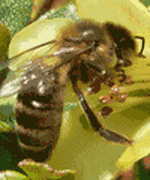Researchers identify new components of the epigenetic 'code' for honey bee development

Researchers from the UK and Australia have uncovered a new element of the honeybee's genetic makeup, which may help to explain why bees are so sensitive to environmental changes.
Scientists from the University of Sheffield, Queen Mary, University of London and the Australian National University, have found that honeybees have a 'histone code' – a series of marks on the histone proteins around which their DNA is wrapped in order to fit into the nucleus of a cell. This code is known to exist in humans and other complex organisms in order to control changes in cell development – but this is the first time it's been discovered in the honeybee. Histone codes can also be affected by nutrition and environmental factors, so the scientists believe the finding may be another part of the puzzle to explain how eating royal jelly ensures honeybee larvae turn into queens and not workers.
"The development of different bees from the same DNA in the larvae is one of the clearest examples of epigenetics in action – mechanisms that go beyond the basic DNA sequence," explains Dr Mark Dickman from the University of Sheffield's Faculty of Engineering. "From our knowledge of how the histone code works in other organisms, we think that the marks on the histone proteins might act as one of the switches that control how the larvae develop."
The scientists believe their findings will open the door to further study of the interplay between environment, nutrition and how the honey bee develops. The first step will be to identify exactly how larval diet influences the histone code to ensure development into either a queen or a sterile worker.
But the potential impact is much wider, as Dr Paul Hurd, from Queen Mary's School of Biological and Chemical Sciences, explains; "Indirect dietary-mediated effects are also of particular relevance to insect pollinators. Prime examples are from systemic pesticides used on agricultural crops, which accumulate inside nectar and pollen and therefore enter honey bee diet, in some cases with detrimental effect. By studying the impact of diet and particular chemicals on the histone code during honey bee development and behaviour, we may be able to identify how certain pesticides contribute to the decline of some colonies."
Professor Maleszka of the Australian National University adds; "We really need to begin looking beyond classical genetics to understand many of the current problems honey bees face including Colony Collapse Disorder. There are rarely single genes that cause a given disease; it's more often interactions between a number of genes that's heavily influenced by environmental factors. Histone codes are flexible and have the capacity to act as an interface between genome and environment".
More information: Extensive histone post-translational modification in honey bees by Mark J. Dickman, Robert Kucharski, Ryszard Maleszka, and Paul J. Hurd is in press and due to appear in a future issue of Insect Biochemistry and Molecular Biology. It is published online at: dx.doi.org/10.1016/j.ibmb.2012.11.003
Provided by University of Sheffield



















